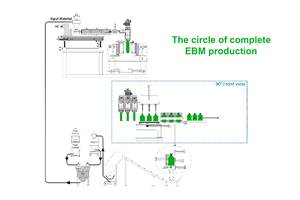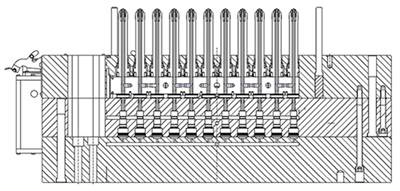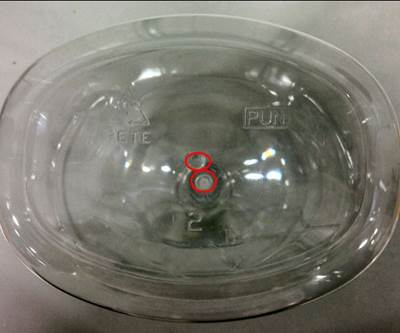Solve Four Common Problems in PET Stretch-Blow Molding
Here’s a quick guide to fixing four nettlesome problems in processing PET bottles.
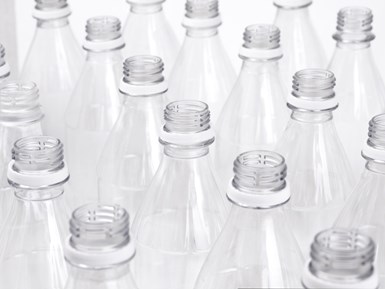
Pearlescence, haze, rocker bottoms, and top-load failure are common ills that can afflict PET bottles. Cures for all of these are readily available.
An article in the December 2014 issue (Blow Molding Know-How) offered tips on how to address uneven wall thickness in stretch-blow molding. While that’s a crucial issue, it’s hardly the only one that processors must deal with on a day-to-day basis. The following are four other common issues, applicable to both single- and two-stage processes.
1. Pearlescence and haze
These are really problems of opposite nature that nevertheless can be hard to distinguish, as both lead to a whitening of the bottle.
Pearlescence is also called stress-whitening, pointing more clearly to its causes. When PET is overstretched, its microstructure can break up, and the resulting wall shows a number of little white circles, hence the connection to “pearls.” Overstretching is a function of both wall thickness and temperature—i.e., a thin wall at a temperature well over the glass-transition point may perform perfectly well, whereas a thicker but colder wall may show pearlescence.
Pearlescence always happens on the inside of the bottle because the inside of the preform has to stretch so much more. Understanding this makes it easier to solve the problem. If the affected area is very thin, it should be cooled down and the area underneath it should be heated to bring more material into the whitish part of the bottle. If it is reasonably thick, the temperature in this section (or overall) should be increased to allow it stretch more easily.
In two-stage (reheat) blow molding, this is accomplished by changing the lamp or ventilation settings. In single-stage molding, overall heat is controlled by holding and cooling time while a change in injection speed can be used to change the temperature in the preform.
Haze develops when PET in either injection or blow stages is heated beyond about 115°C (240°F) and allowed to cool down for even a short time. At this temperature, PET molecules have enough freedom to form crystals, and that is precisely what they will do because it allows for a lower energy state. In two-stage, the responsible lamp can easily be found and must be turned down or ventilation increased to keep the preform temperature below 115°C/240°F. Haze always happens on the outside of the preform and ventilation will cool this part more than the inside. In the single-stage process, cooling and/or hold time are the timers that are increased to combat haze.
Lightweighting has forced more attention to topload strength.
2. Insufficient top-load strength
As bottle weights are constantly reduced to save on resin use and expense, top-load strength has become a much more important issue. Top-load is usually measured on empty bottles in a suitable device with adjustable speed. The measured value is then compared with the static load (how many bottles are on top of the bottom pallet layer) and multiplied with a factor of safety (or ignorance) to account for dynamic loads when a truck goes over a bump and the entire load is accelerated up and down. Multiplying static load by two, three, or four is not a very scientific method, and some companies have measured the actual load in a moving truck with sometimes surprising results.
Top-load performance depends almost exclusively on wall thickness and bottle design. Bottles collapse at the weakest part of the bottle—be it shoulder, bottom, or body. Processors must know where the bottle failed so they can move more material into this area.
One vexing issue is that top-load values of empty bottles are of interest to no one, since empty bottles do not fail because of top loading. Some bottles will show the same behavior whether they are full or empty, but others will perform up to four times better when they are filled. Brand owners can of course draw their own conclusions, but processors should have a discussion about necessary top load with their customers if this is the case.
3. Insufficient base clearance or rocker bottom

When the base is too hot after molding, it will shrink outward and form a center leg that makes the bottle rock, hence the name “rocker bottom.”
All bottles have what is usually referred to as a push-up: The center of the bottom curves inward to various degrees. This is to ensure that the bottle sits on the outer rim of the base or, in the case of bottles for carbonated beverages, on feet, typically five. This center push-up will always shrink outward to some degree.
When it is too hot after molding, it will move out so much that it starts to protrude beyond the limits of the outer rim, and the bottle “rocks” instead of standing straight. It can also happen that residual air pressure inside the bottle pushes the center of the bottom out when the mold opens, even though this is a rather rare occurrence. On some machines, cooling jets blow air on the bottoms of the bottles after molding to prevent that shrinking-out. Otherwise, the processor has to reduce heat on the bottom of the preform or increase cooling time.
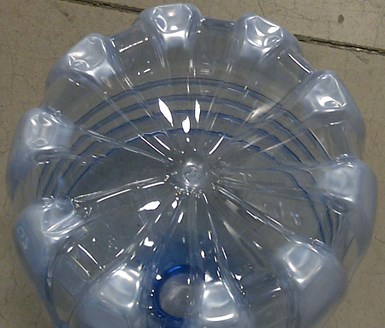
A good indicator of pearlescence is its occurrence in highly stretched areas like the feet in this 15 L container.
Base clearance—the distance of the center of the bottle bottom to the feet—is of utmost importance for carbonated beverages. This is because the carbonation in the product can exert pressure of up to 70 psi inside the bottle. This pressure then pushes on the center disk of the bottle base, which therefore has to have some room to move before it exceeds the depth of the feet. Base clearance should be measured in short intervals, typically 2 hr. It is often the one parameter that keeps machines from running faster because of the necessary cooling time.
Insufficient orientation in thin spots is more common in single-stage than two-stage molding.
4. Drop-impact failure
Bottles must withstand being dropped from 4 to 5 ft containing water at around 4°C (40°F) to simulate conditions in a household refrigerator. Contrary to polyolefins, PET does not break at the thinnest corner (unless there is pearlescence or haze); it may dent but will not break because it is highly oriented in these thin spots. A lack of orientation is therefore the most common cause of failure, most often found in custom bottles with small stretch ratios and more common in single-stage than in two-stage molding.
In two-stage molding, a cooler preform temperature will force more orientation into the material and improve performance. In single-stage processes, cooling or hold time must be added, which will increase cycle time. Hold time has more impact because the preform shrinks away from the core during the cooling phase and is therefore preferred. When preforms are overheated to the point of haze, the crystalline areas are more brittle and can also fail. The same remedy applies.
ABOUT THE AUTHOR
Ottmar Brandau has been working in the plastics industry since 1978 and is the president of PET All Manufacturing Inc. His book, The Rapid Guide to Perfect PET Bottles, describes 30 common problems and their solutions. It can be found at blowmolding.org/shop. Contact: (705) 429-1492; info@blowmolding.org.
Related Content
Understanding the ‘Science’ of Color
And as with all sciences, there are fundamentals that must be considered to do color right. Here’s a helpful start.
Read More50 Years of Headlines … Almost
I was lucky to get an early look at many of the past half-century’s exciting developments in plastics. Here’s a selection.
Read MoreHow to Extrusion Blow Mold PHA/PLA Blends
You need to pay attention to the inherent characteristics of biopolymers PHA/PLA materials when setting process parameters to realize better and more consistent outcomes.
Read MoreGet Color Changes Right In Extrusion Blow Molding
Follow these best practices to minimize loss of time, material and labor during color changes in molding containers from bottles to jerrycans. The authors explore what this means for each step of the process, from raw-material infeed to handling and reprocessing tails and trim.
Read MoreRead Next
BLOW MOLDING: Single- or Two-Stage PET Bottle Making: Get to Know Your Options
The decision which process to use can be quite complex. Here are pointers that will help you to choose the right one for your application
Read MoreHow to Address Uneven Wall Thickness in Stretch-Blow Molding
Many conditions must be met to get the best wall distribution in a PET bottle. Skilled operators are, as always, indispensable.
Read MoreSolving the Bane of Stretch-Blow Molding: Off-Center Gates
There are many reasons why off-center gates happen, and processors should be aware of all of them to quickly find the ones causing the problem.
Read More

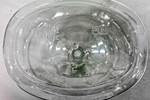
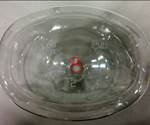



.png;maxWidth=300;quality=90)


















